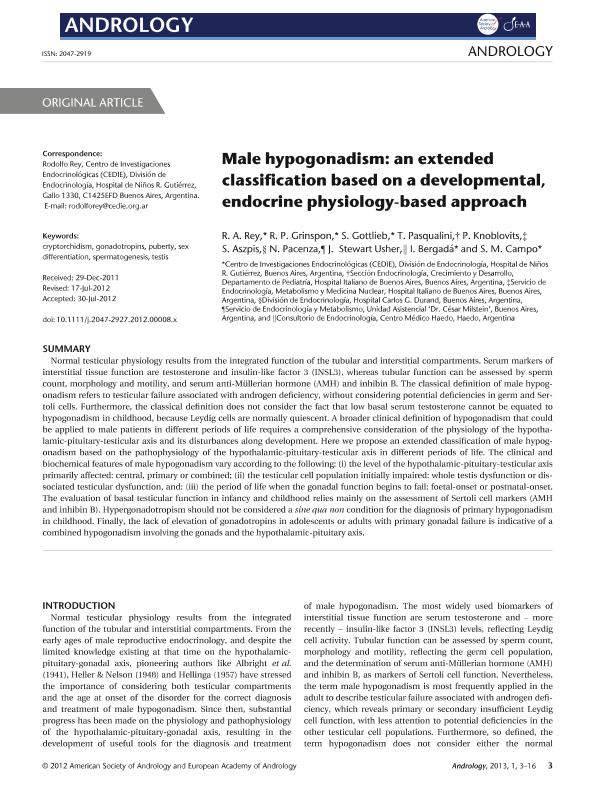Mostrar el registro sencillo del ítem
dc.contributor.author
Rey, Rodolfo Alberto

dc.contributor.author
Grinspon, Romina

dc.contributor.author
Gottlieb, Silvia Elisa

dc.contributor.author
Pascualini, T.
dc.contributor.author
Knoblovits, P.
dc.contributor.author
Aszpis, S.
dc.contributor.author
Pacenza, N.
dc.contributor.author
Stewart Usher, J.
dc.contributor.author
Bergadá, Ignacio
dc.contributor.author
Campo, Stella Maris

dc.date.available
2016-11-10T17:59:23Z
dc.date.issued
2013-01
dc.identifier.citation
Rey, Rodolfo Alberto; Grinspon, Romina; Gottlieb, Silvia Elisa; Pascualini, T.; Knoblovits, P.; et al.; Male hypogonadism: an extended classification based on a developmental, endocrine physiology-based approach; Wiley; Andrology; 1; 1; 1-2013; 3-16
dc.identifier.issn
2047-2927
dc.identifier.uri
http://hdl.handle.net/11336/8127
dc.description.abstract
Normal testicular physiology results from the integrated function of the tubular and interstitial compartments. Serum markers of interstitial tissue function are testosterone and insulin-like factor 3 (INSL3), whereas tubular function can be assessed by sperm count, morphology and motility, and serum anti-Mu¨llerian hormone (AMH) and inhibin B. The classical definition of male hypogonadism refers to testicular failure associated with androgen deficiency, without considering potential deficiencies in germ and Sertoli cells. Furthermore, the classical definition does not consider the fact that low basal serum testosterone cannot be equated to hypogonadism in childhood, because Leydig cells are normally quiescent. A broader clinical definition of hypogonadism that could be applied to male patients in different periods of life requires a comprehensive consideration of the physiology of the hypothalamic- pituitary-testicular axis and its disturbances along development. Here we propose an extended classification of male hypogonadism based on the pathophysiology of the hypothalamic-pituitary-testicular axis in different periods of life. The clinical and biochemical features of male hypogonadism vary according to the following: (i) the level of the hypothalamic-pituitary-testicular axis primarily affected: central, primary or combined; (ii) the testicular cell population initially impaired: whole testis dysfunction or dissociated testicular dysfunction, and: (iii) the period of life when the gonadal function begins to fail: foetal-onset or postnatal-onset. The evaluation of basal testicular function in infancy and childhood relies mainly on the assessment of Sertoli cell markers (AMH and inhibin B). Hypergonadotropism should not be considered a sine qua non condition for the diagnosis of primary hypogonadism in childhood. Finally, the lack of elevation of gonadotropins in adolescents or adults with primary gonadal failure is indicative of a combined hypogonadism involving the gonads and the hypothalamic-pituitary axis.
dc.format
application/pdf
dc.language.iso
eng
dc.publisher
Wiley

dc.rights
info:eu-repo/semantics/openAccess
dc.rights.uri
https://creativecommons.org/licenses/by-nc-sa/2.5/ar/
dc.subject
Cryptorchidism
dc.subject
Gonadotropins
dc.subject
Puberty
dc.subject
Sex Differentiation
dc.subject
Spermatogenesis
dc.subject
Testis
dc.subject.classification
Endocrinología y Metabolismo

dc.subject.classification
Medicina Clínica

dc.subject.classification
CIENCIAS MÉDICAS Y DE LA SALUD

dc.title
Male hypogonadism: an extended classification based on a developmental, endocrine physiology-based approach
dc.type
info:eu-repo/semantics/article
dc.type
info:ar-repo/semantics/artículo
dc.type
info:eu-repo/semantics/publishedVersion
dc.date.updated
2016-11-10T13:52:38Z
dc.journal.volume
1
dc.journal.number
1
dc.journal.pagination
3-16
dc.journal.pais
Reino Unido

dc.journal.ciudad
Londres
dc.description.fil
Fil: Rey, Rodolfo Alberto. Consejo Nacional de Investigaciones Científicas y Técnicas. Oficina de Coordinación Administrativa Parque Centenario. Centro de Investigaciones Endocrinológicas; Argentina
dc.description.fil
Fil: Grinspon, Romina. Consejo Nacional de Investigaciones Científicas y Técnicas. Oficina de Coordinación Administrativa Parque Centenario. Centro de Investigaciones Endocrinológicas; Argentina
dc.description.fil
Fil: Gottlieb, Silvia Elisa. Consejo Nacional de Investigaciones Científicas y Técnicas. Oficina de Coordinación Administrativa Parque Centenario. Centro de Investigaciones Endocrinológicas; Argentina
dc.description.fil
Fil: Pascualini, T.. Hospital Italiano de Buenos Aires; Argentina
dc.description.fil
Fil: Knoblovits, P.. Hospital Italiano de Buenos Aires; Argentina
dc.description.fil
Fil: Aszpis, S.. Hospital "Carlos G. Durand"; Argentina
dc.description.fil
Fil: Pacenza, N.. Unidad Asistencial "Dr. César Milstein"; Argentina
dc.description.fil
Fil: Stewart Usher, J.. Centro Médico Haedo; Argentina
dc.description.fil
Fil: Bergadá, Ignacio. Consejo Nacional de Investigaciones Científicas y Técnicas. Oficina de Coordinación Administrativa Parque Centenario. Centro de Investigaciones Endocrinológicas; Argentina
dc.description.fil
Fil: Campo, Stella Maris. Consejo Nacional de Investigaciones Científicas y Técnicas. Oficina de Coordinación Administrativa Parque Centenario. Centro de Investigaciones Endocrinológicas; Argentina
dc.journal.title
Andrology
dc.relation.alternativeid
info:eu-repo/semantics/altIdentifier/url/http://onlinelibrary.wiley.com/doi/10.1111/j.2047-2927.2012.00008.x/abstract
dc.relation.alternativeid
info:eu-repo/semantics/altIdentifier/doi/http://dx.doi.org/10.1111/j.2047-2927.2012.00008.x
Archivos asociados
